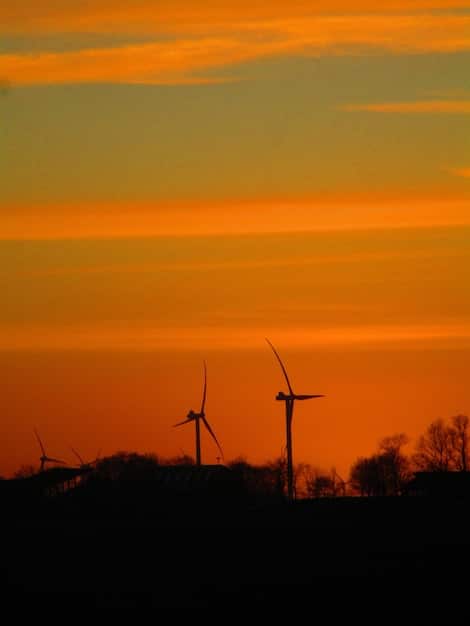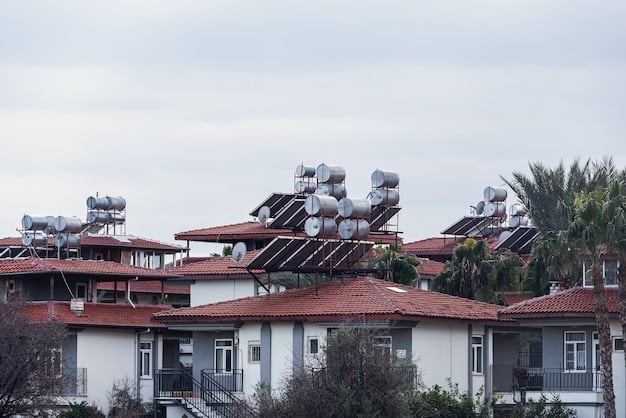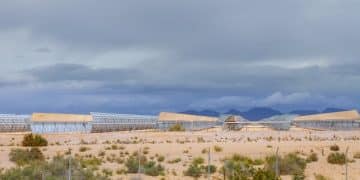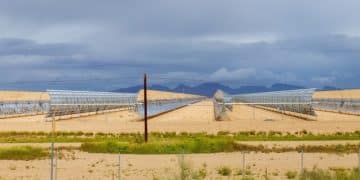US Government’s Climate Change Response & Impact on Communities

The US government is addressing climate change through policies like the Inflation Reduction Act, investments in renewable energy, and initiatives aimed at protecting vulnerable communities from climate-related disasters and environmental injustices.
The US government is increasingly focused on addressing climate change and mitigating its impacts on vulnerable communities. This article explores the strategies, policies, and initiatives being implemented to tackle this critical issue.
Understanding the US Government’s Approach to Climate Change
The US government recognizes climate change as a significant threat to the environment, economy, and public health. Its approach involves a multi-faceted strategy that includes setting emission reduction targets, investing in clean energy technologies, and promoting international cooperation.
Key Policies and Regulations
Several key policies and regulations form the backbone of the US government’s climate change initiatives. These measures aim to reduce greenhouse gas emissions and promote sustainable practices across various sectors.
These policies not only address climate change but also aim to create economic opportunities and foster innovation in clean energy technologies.
- The Clean Air Act: Regulates air emissions from stationary and mobile sources.
- The Inflation Reduction Act: Provides substantial investments in clean energy and climate resilience.
- Executive Orders: Direct federal agencies to incorporate climate considerations into their decision-making processes.
Implementing these policies requires coordination among federal agencies, state governments, and local communities to ensure effective and equitable outcomes.

The Impact of Climate Change on Vulnerable Communities
Climate change disproportionately affects vulnerable communities, including low-income populations, communities of color, and indigenous groups. These communities often lack the resources to adapt to climate-related hazards and are more likely to live in areas prone to environmental risks.
Rising Sea Levels and Coastal Communities
Coastal communities face the immediate threat of rising sea levels, leading to increased flooding, erosion, and displacement. The US government is working to protect these communities through adaptation measures and infrastructure investments.
Efforts to mitigate the impacts of rising sea levels require collaboration between federal, state, and local authorities to develop comprehensive resilience plans.
- Infrastructure Improvements: Constructing sea walls and improving drainage systems.
- Relocation Assistance: Providing support for communities forced to relocate due to rising waters.
- Policy Changes: Implementing zoning regulations that restrict development in vulnerable areas.
These strategies aim to balance immediate protection measures with long-term planning to ensure the sustainability of coastal communities.
Federal Initiatives to Support Climate Resilience
The US government has launched several initiatives to support climate resilience, particularly in vulnerable communities. These programs provide funding, technical assistance, and resources to help communities adapt to the impacts of climate change.
FEMA’s Role in Climate Resilience
The Federal Emergency Management Agency (FEMA) plays a crucial role in supporting climate resilience through disaster preparedness and response. FEMA provides resources to help communities prepare for and recover from climate-related disasters.
FEMA’s efforts include providing financial assistance, technical expertise, and training to help communities build resilience against future disasters.
Such initiatives contribute to a more comprehensive approach to climate resilience, ensuring that resources are available to those who need them most.
Investing in Renewable Energy and Clean Technology
A key component of the US government’s climate change strategy is investing in renewable energy and clean technology. These investments aim to reduce reliance on fossil fuels and transition to a cleaner, more sustainable energy system.
Tax Incentives for Renewable Energy
The US government offers tax incentives to encourage the development and deployment of renewable energy projects. These incentives make renewable energy technologies more economically competitive.
These tax credits and grants support the growth of the renewable energy sector and incentivize private investment in clean technology innovation.
These efforts are essential for achieving long-term emission reduction targets and promoting a sustainable energy future.

Addressing Environmental Justice
Environmental justice is a critical aspect of the US government’s climate change efforts. This involves ensuring that all communities, regardless of race, ethnicity, or income, have equal protection from environmental hazards and equal access to environmental benefits.
EPA’s Environmental Justice Programs
The Environmental Protection Agency (EPA) has implemented several programs to address environmental justice concerns. These programs aim to reduce pollution in overburdened communities and promote equitable environmental policies.
EPA’s initiatives include monitoring pollution levels, engaging with community stakeholders, and providing grants for environmental cleanup projects.
- Community Engagement: Working directly with communities to identify and address environmental concerns.
- Grant Programs: Providing funding for local environmental projects.
- Policy Reform: Revising regulations to better protect vulnerable populations.
These programs help ensure that environmental protection efforts benefit all communities, particularly those that have historically been marginalized.
International Cooperation and Agreements
The US government recognizes that climate change is a global problem that requires international cooperation. The US actively participates in international agreements and initiatives to address climate change on a global scale.
The Paris Agreement
The Paris Agreement is a landmark international agreement that sets goals for reducing greenhouse gas emissions and limiting global warming. The US has rejoined the Paris Agreement and is committed to meeting its emission reduction targets.
By working with other nations, the US can leverage its resources and expertise to promote global climate action and support vulnerable countries in their adaptation efforts.
International cooperation is crucial for achieving meaningful progress in addressing climate change and protecting the planet for future generations.
Challenges and Future Directions
Despite significant progress, the US government faces ongoing challenges in addressing climate change and its impacts on vulnerable communities. These challenges include political opposition, funding constraints, and the need for more effective implementation of policies.
Overcoming Political Obstacles
Political opposition remains a significant obstacle to climate action in the US. Overcoming this challenge requires building broad-based support for climate policies and engaging with stakeholders across the political spectrum.
Despite these challenges, continued efforts to address climate change and protect vulnerable communities are essential for building a more sustainable and equitable future.
| Key Point | Brief Description |
|---|---|
| 🌱 Policy Initiatives | Measures like the Clean Air Act and Inflation Reduction Act aim to reduce emissions. |
| 🌊 Vulnerable Communities | Protecting groups disproportionately affected by climate change impacts. |
| ⚡Renewable Energy | Investing in solar, wind, and other clean energy sources. |
| 🤝 International Agreements | Participating in global efforts like the Paris Agreement. |
Frequently Asked Questions
▼
The Inflation Reduction Act is a law that includes significant investments in clean energy and climate resilience. It provides tax credits, grants, and other incentives to promote renewable energy and reduce greenhouse gas emissions.
▼
The US government provides funding and resources through programs like FEMA to help vulnerable communities prepare for and recover from climate-related disasters. It also focuses on environmental justice initiatives.
▼
The EPA sets regulations to reduce pollution, promotes environmental justice, and provides grants for environmental cleanup projects. It aims to ensure all communities have equal protection from environmental hazards.
▼
The US government offers tax incentives and grants to encourage the development and deployment of renewable energy projects. These incentives make renewable energy technologies more economically competitive.
▼
The Paris Agreement is an international agreement that sets goals for reducing greenhouse gas emissions and limiting global warming. The US has rejoined the agreement and is committed to meeting its emission reduction targets.
Conclusion
The US government’s response to climate change and its impact on vulnerable communities involves a multifaceted approach comprising policy implementation, financial investments, and international collaboration. While challenges persist, ongoing efforts aim to build a more sustainable and equitable future for all.





